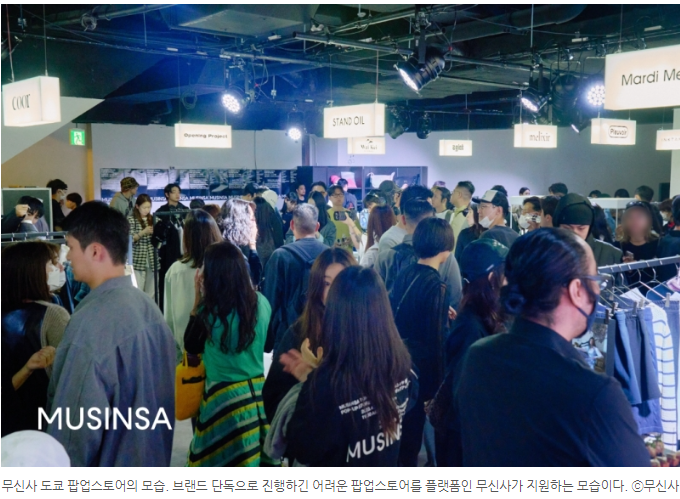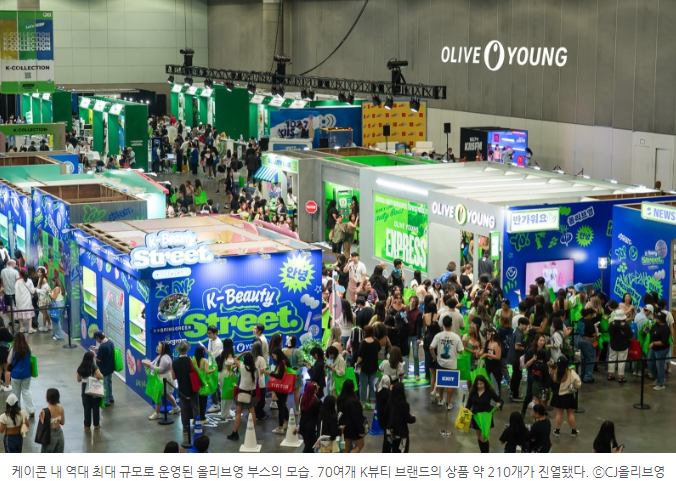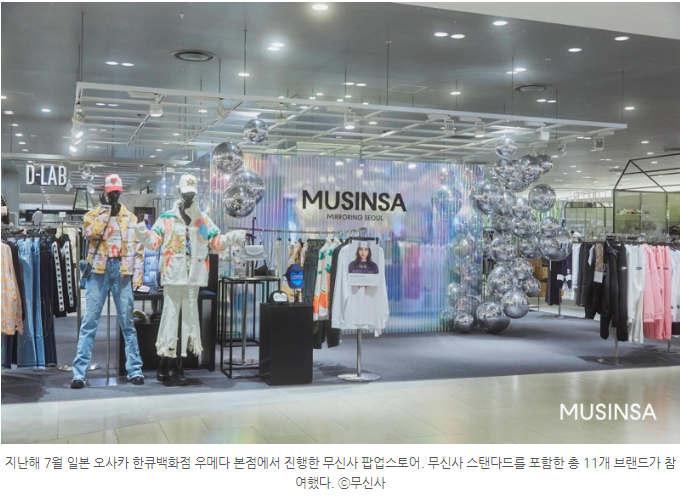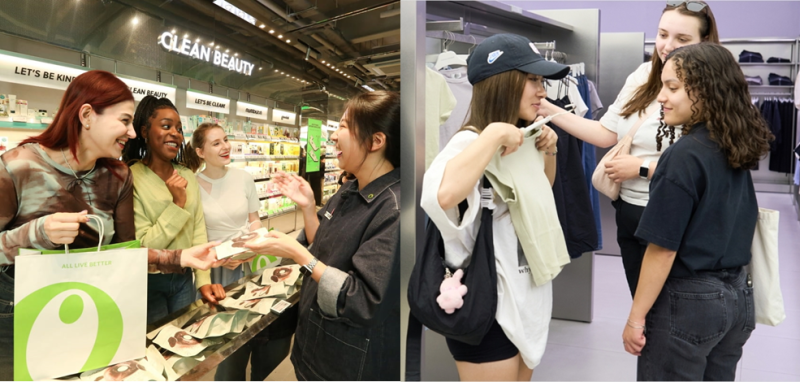Musinsa VS Olive Young: Comparing Their Similar Yet Different Global Expansion Strategies
🛫 Here's what you can learn from this article!
- Musinsa and Olive Young, the top domestic retail companies in fashion and beauty vertical sectors respectively, are now seriously focused on 'going global'. They have been preparing for overseas expansion for several years, and recently started to disclose their achievements. Musinsa's global transaction volume for the first half of this year grew 2.5 times compared to the previous year, while Olive Young's global mall sales growth rate reached 80% last year. But did you know that their global expansion strategies are similar yet different?
- To compare Musinsa and Olive Young's overseas expansion strategies, it's necessary to first understand the foundations of K-fashion and K-beauty. While both K-fashion and K-beauty share the same root of global popularity in K-content, their textures are quite different. This is where we can find the reason why these two companies, both advocating 'brand first', are strategically focusing on different areas.
- There are also many 'commonalities' in Musinsa and Olive Young's global strategies. A notable similarity is that both companies are using their domestic offline stores as outposts for overseas expansion. Recent analysis suggests that their competition for the rights to use the 'Seongsu Station Name' was driven by this hidden agenda for 'global branding'. You can learn more details about this.
- So, between Musinsa and Olive Young, who are competitively expanding overseas, which one has a higher chance of success? As the vertical areas where these two companies have their strengths and their global strategies are not the same, their potential is naturally evaluated differently. We've compared them from both short-term and long-term perspectives.
CHAPTER 1
Doing Well Globally Too?
Vertical commerce can grow sharply based on its unique expertise, but it inevitably faces growth limitations in the domestic market alone. This naturally leads to turning attention to the global market. Musinsa and Olive Young, undisputed leaders in their respective vertical areas of fashion and beauty, were no exception.
Musinsa and Olive Young have been aggressively preparing for overseas expansion for several years, and recently began to disclose their achievements. First, Musinsa's global transaction volume in the first half of this year grew more than 2.5 times compared to the previous year. This was particularly meaningful as emerging brands like Stand Oil and Glowny showed notable performances.
Olive Young is also impressive. Last year, their global mall's sales growth rate reached 80%, and in the Japanese market, which they're focusing on, Olive Young brand sales have increased by an average of 125% annually over the past four years.
Of course, there have been successful cases of fashion and beauty companies in overseas markets before. In the fashion industry, E-Land and F&F, and in the beauty industry, large corporations like LG Household & Health Care and Amore Pacific have achieved remarkable results, mainly in the Chinese market.
However, the recent global expansion trend has changed slightly from the past. The main stage has shifted from China to Japan and the United States, and 'indie brands' have become the main players in overseas expansion. Retail companies, rather than brand companies developing multiple brands, are leading the charge in overseas expansion. This is exactly what Musinsa and Olive Young are doing.
Interestingly, their great success domestically was also due to creating an ecosystem centered on 'indie brands'. In this process, unlike past retail companies, they uniquely positioned themselves as 'brand helpers' rather than simply approaching as distributors. They are incorporating this experience into their global expansion process as well. Given their similar backgrounds, the two companies' global expansion strategies share many similarities. However, there are also some interesting differences. Today, we'll compare and discuss how Musinsa and Olive Young, the top platforms in two different vertical areas, are targeting the global market.
CHAPTER 2
Even with the Same 'K', the Texture is Different
To compare Musinsa and Olive Young's overseas expansion strategies, we first need to understand the foundations of K-fashion and K-beauty. In recent years, the global business performance of domestic brands has notably increased across fashion, beauty, and even food (though we won't cover that today).
Basically, the reason for attaching 'K' to these category names is that the popularity of pop culture and content, including K-pop, has greatly influenced their success. Korean idols, dramas, and movies have raised the brand value of Korea, leading to product consumption beyond simple cultural enjoyment. For example, when people become interested in K-pop idols, they naturally notice what they wear, apply, and eat.
However, K-fashion and K-beauty have distinctly different textures. K-fashion focuses on individuality and style. Designer brands are central, and most are relatively high-priced. Therefore, their expansion channels are quite limited.

For instance, in the Japanese market where many brands are expanding, the main approach is to prove potential through pop-up stores before opening permanent stores. This requires sophisticated branding, which cannot be fulfilled in online marketplaces.
On the other hand, K-beauty focuses on functionality and efficacy. Most are mid to low-priced brands emphasizing cost-effectiveness. This was possible because two of the world's top three cosmetic ODM companies (Cosmax, Kolmar Korea) are based in Korea. With their technology and production infrastructure, anyone with ideas and planning skills could create good quality cosmetics at reasonable prices.
The strategy of indie beauty brands born this way is simple but powerful. They raise awareness through social media like TikTok or Reels, and sell through marketplaces like Amazon and Qoo10. Many brands are achieving great success, particularly ranking high on Amazon US.
To summarize Musinsa and Olive Young's global expansion in one keyword, it would be 'Brand First'. They both introduce brands to the market to expand their foothold and use this as a basis to extend the influence of their global malls. However, as explained earlier, because the characteristics of fashion and beauty brands differ, there are differences in the roles they pursue.
CHAPTER 3
Musinsa Chooses to be a 'Brand Curator'
First, Musinsa aims to be a K-fashion curator. Just as Musinsa has been discovering good brands and pursuing mutual growth domestically, it introduces promising brands overseas and provides comprehensive packages and plans to help them establish themselves. A fashion PR industry insider in Japan even remarked, "Musinsa is perceived as a curator of K-trends."
In fact, there are far more barriers for domestic designer brands to expand overseas compared to beauty brands. To maintain their unique brand sensibility and value, they need to build their own official online stores, and especially in conservative markets like Japan, they must establish an 'offline touchpoint' in the initial stages. However, operating pop-up stores and opening local shops are challenging for small and medium-sized brands to do on their own.

Musinsa is addressing these difficulties on behalf of the brands and building partnerships with them. In this way, Musinsa is attracting more good brands, ultimately aiming to position its global mall as the trendiest K-fashion platform. To this end, they are also making continuous branding efforts, such as appointing NewJeans as their global ambassador.
CHAPTER 4
Olive Young Runs as a Direct Player
In contrast, Olive Young is closer to being a direct K-beauty player. This is because they are focusing not only on their global mall business but also on nurturing their own beauty brands such as Biopeulen and WAKEMAKE.
Olive Young's choice was partly inevitable because beauty brands could expand overseas without necessarily going through Olive Young. For example, COSRX, Klaver (Skin Angel), and Goodal Global (Chosungah22) are already achieving great success in the U.S. market independently. Unlike fashion brands that often establish themselves domestically before going global, many beauty brands start their businesses in earnest overseas. From their perspective, they don't necessarily need the assistance of Olive Young, which has less global recognition compared to its domestic presence.
Therefore, Olive Young is reversely trying to grow its 'own brands' into global brands by benchmarking the success cases of these brands. With functions already proven in Korea and competitive prices, they are achieving some success.
Of course, this doesn't mean that Olive Young isn't supporting small and medium-sized brands in their global expansion. Olive Young also provides overseas logistics and marketing support for these brands. They even operated a booth at the K-pop festival 'KCON' held in Los Angeles from July 26 to 28, organized by CJ ENM, to support their branding.
Unlike fashion brands that often establish themselves domestically before going global, many beauty brands start their businesses in earnest overseas. From their perspective, they don't necessarily need the assistance of Olive Young, which has less global recognition compared to its domestic presence.

Therefore, Olive Young is reversely trying to grow its 'own brands' into global brands by benchmarking the success cases of these brands. With functions already proven in Korea and competitive prices, they are achieving some success.
Of course, this doesn't mean that Olive Young isn't supporting small and medium-sized brands in their global expansion. Olive Young also provides overseas logistics and marketing support for these brands. They even operated a booth at the K-pop festival 'KCON' held in Los Angeles from July 26 to 28, organized by CJ ENM, to support their branding.

CHAPTER 5
'Offline' Becomes the Global Outpost
There are overlapping points in Musinsa and Olive Young's global expansion strategies. Specifically, they are using their domestic offline stores as outposts for overseas expansion. The strategy of both companies to secure major tourist attractions in Seoul and expand overseas based on this is likely to continue strengthening.
First, Olive Young classifies and specially manages stores where foreign tourist sales account for over 50% as global core tourist district stores. There are as many as 60 such stores. They are using a strategy to provide 'omnichannel' experiences to foreign customers visiting these stores, connecting them to the global mall, and thereby promoting performance in overseas markets.
The pinnacle of this was Olive Young's recent headline-making purchase of the 'Seongsu Station Name'. Seongsu-dong has recently become the hottest tourist destination for foreigners, reportedly a must-visit place for young foreign tourists. Olive Young is opening a new large store here to gather foreign customers, and above all, seems intent on overlaying Olive Young's brand with Seongsu's trendy image.
On the other hand, Musinsa has also actively expanded its contact points with both domestic and foreign customers by opening stores in major commercial areas of Seoul such as Gangnam, Hongdae, Myeong-dong, and Apgujeong. In fact, Musinsa stores operate foreign language brochures and separate introduction pages in English and Japanese.
In this offline expansion, the area Musinsa has been most focused on is 'Seongsu'. Seongsu has so many offline spaces that it wouldn't be strange to call it Musinsa Town. This was aimed not only at domestic customers but also at overseas customers. Ironically, it was Musinsa that competed with Olive Young for the ownership of the Seongsu Station name.
And recently, Musinsa is expanding its territory to Hannam-dong. They plan to unveil their largest ever Musinsa Standard store in Hannam-dong at the end of this month. Hannam-dong is particularly symbolic as it's an area where showrooms of designer brands like Mardi Mercredi, Maison Margiela, Porter, and A.MOMENT are concentrated. Many foreign tourists are already visiting these showrooms, and Musinsa is joining them, aiming not to miss out on the position of K-fashion's leading player.
CHAPTER 6
Predicting Future Possibilities
So, between Musinsa and Olive Young, who are competitively expanding overseas, which one has a higher chance of success?
From a short-term perspective, Olive Young's approach seems slightly more advantageous. This is because K-beauty is ahead in terms of financial performance, with several brands already recording sales in the hundreds of billions of won based on their overseas market performance. Moreover, the popularity of domestic beauty brands is a more universal trend, so if utilized well, it has a high potential to significantly impact Olive Young's overall performance.
On the other hand, from a long-term perspective, Musinsa might be able to produce better results. Musinsa's approach may be disadvantageous in terms of immediate success potential or expected performance. However, brands that secure a solid fandom tend to last longer, even if they bear fruit later. Therefore, it can be said that Musinsa is drawing a roadmap that looks further into the future while creating an ecosystem with brands.
Contact us and we'll help you learn more and connect your business. cs@beyondx.ai



